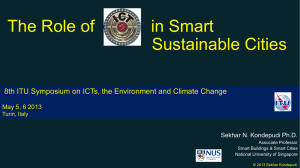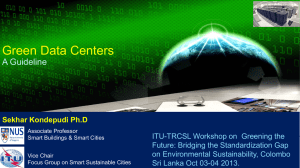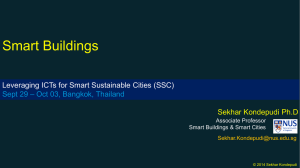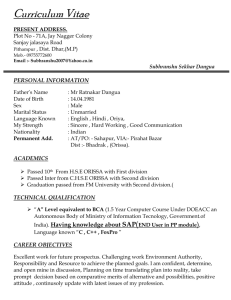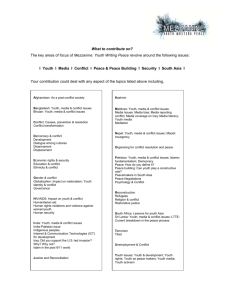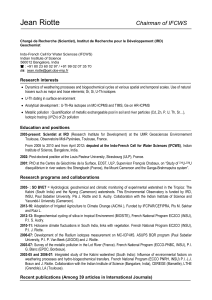Smart Sustainable Buildings Sekhar Kondepudi, PhD.
advertisement
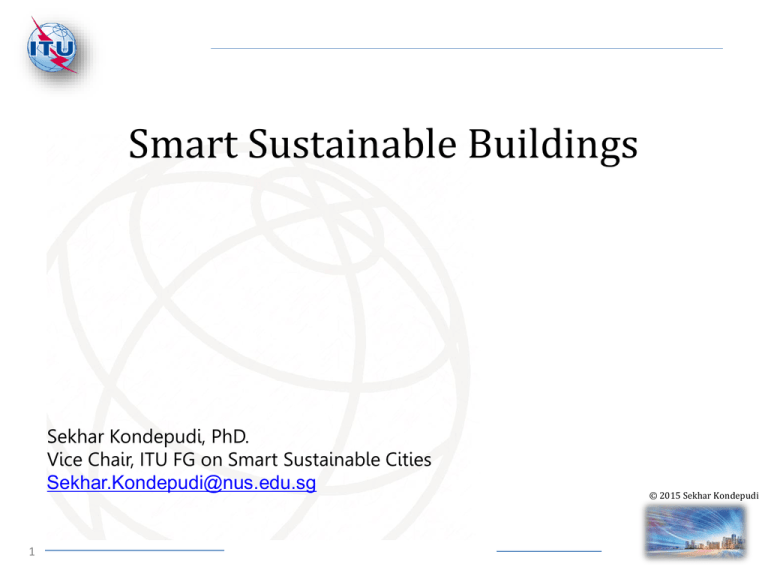
Smart Sustainable Buildings Sekhar Kondepudi, PhD. Vice Chair, ITU FG on Smart Sustainable Cities Sekhar.Kondepudi@nus.edu.sg 1 © 2015 Sekhar Kondepudi Agenda 2 1 Why are Buildings Important ? 2 Typical Systems in a Building 3 A “Smart” Building 4 Examples 5 Wrap Up & Discussion © 2015 Sekhar Kondepudi Agenda 3 1 Why are Buildings Important ? 2 Typical Systems in a Building 3 A “Smart” Building 4 Examples 5 Wrap Up & Discussion © 2015 Sekhar Kondepudi Buildings … • • • • • Where we spend 90% of our lives Where we spend 70% of our electricity Where we spend 50% of our energy Where we spend 40% of our CO2 emissions Natural counterbalance to fluctuating renewables • where we spend a lot of our $’s • 2/3rds of the occupants are uncomfortable 4 © 2015 Sekhar Kondepudi Wide Range of Building Types © 2015 Sekhar Kondepudi City / Community = 6 Buildings Schools Universities Government Residential Sports & Entertainment Hospitality Energy Transportation Retail Source - Cisco Hospitals 6 © 2015 Sekhar Kondepudi 6 Agenda 7 1 Why are Buildings Important ? 2 Typical Systems in a Building 3 A “Smart” Building 4 Examples 5 Wrap Up & Discussion © 2015 Sekhar Kondepudi A Building = Indoor Air Air Quality Filters Cameras Services Many Devices & Sub-Systems Air Handling Unit Controllers Cooling Coils SolarPV Exhaust Fans Smoke Detectors Cooling Towers VAV Elevators Lighting Halon Units Diffusers Zone Heating System Control Units Fans Dampers Cameras Intrusion Detectors Card Readers Access Management Chemical Water Control 8 Thermostats/ Humidistats Pumps Operators Chillers & Station Boilers Computer Room Fire Alarm Air Handlers Panels Rack/Server IDFPDU Parking Garage Electric, Gas, Heating Vending m/c Water Systems © 2015 Sekhar Kondepudi Systems in a Building © 2015 Sekhar Kondepudi The 4th Utility • 3 Traditional Utilities – Gas – Water – Electricity • 4th Utility is Here and Now : – “Communications” © 2015 Sekhar Kondepudi Integrated Approach towards Buildings Integrating Across Silos = IBMS Power HVAC Lighting Access Video Security Life Safety IT Network Life Safety Systems White Space IT Apps Network Mgmt Systems Fire & Smoke Detectors, Sprinklers Servers Computers Wiring Closet Routers Switches Phones Network Power Monitoring Control Systems Emergency Power Supply Utilities 11 Building Automation Systems Lighting Control Active Access Control Biometrics Chillers Boilers Air Handlers Lighting Locks Doors Gates Man-traps Digital Video Recorder Video Analytics Cameras Housings © 2015 Sekhar Kondepudi Need for an Integrated View for Buildings Building management HVAC control Lighting control Access control Security Electrical distribution Energy monitoring Motor control Making the parts work together for energy efficiency Critical power Renewable energy Simple Integration 12 Interoperability and openness of third party systems © 2015 Sekhar Kondepudi Common Building Communications Standards • Common Building Communications Standards include BACNet, LonWorks, ModBus and KNX. • The concept of using a digital IP backbone which can interface to almost any control or monitoring system has gradually become pervasive. So the above protocols are converted to IP • Advantages of a common IP backbone is the immediate and seamless convergence with other IP based systems such as Data Networking, Voice over IP, Video and also Enterprise based systems. • Examples of systems which are readily compatible with an IP backbone include: – – – – – – – – – Audio paging; Fire alarm systems; Telephone systems; HVAC systems; Surveillance systems; Access control and intrusion alarms; Lighting control systems; Elevator control systems; HVAC systems. © 2015 Sekhar Kondepudi Before Convergence ENTERPRISE APPLICATIONS Facility Management Maintenance Management IT Network Management IP Camera IP Telephony Wireless BMS Lighting Control Access Control Building Mgmt DVR BMS Boilers General Lighting VAV FCU AHU Channel Controllers FCU Heat Pump Chillers Occupancy Detectors DSI/DALI Interface Access Control Lighting Control Building Mgmt VAV Chilled Beam 14 CCTV Heat Pump Chilled Beam General Lighting Occupancy Detectors DSI/DALI Interface Source : Cisco © 2015 Sekhar Kondepudi After Convergence Energy Management Building Management Facility Management Security Management Maintenance Management IT Network Management ENTERPRISE APPLICATIONS Middleware Server Disparate Protocols to Common Format + ICT Integration IP Camera IP Telephony Wireless Energy & Power Metering BMS Lighting Control UPS Monitoring CCTV Access Control DVR VAV Boilers FCU AHU Heat Pump Chillers Chilled Beam Fire Alarm System Smoke Sensor Door Controllers General Lighting Break Glass Channel Controllers Occupancy Detectors DSI/DALI Interface Intruder Panels Reader Technology Source : Cisco Sounder 15 © 2015 Sekhar Kondepudi Agenda 1 6 1 Why are Buildings Important ? 2 Typical Systems in a Building 3 A “Smart” Building 4 Examples 5 Wrap Up & Discussion © 2015 Sekhar Kondepudi User Experiences 17 Home/Residential Office Shopping Transportation Imagine having quick and easy access to the information and government services you need to enhance your personal and professional life A building that knew when you arrived and left, automatically turned business applications on and off, sends a security alert when an unidentified package is left, or notifies you about peaking energy use Reserve and pay for parking before leaving home; receive real-time sales incentives on your mobile device upon entering the store; real-time video surveillance system Road, railway, and air transportation is the heart of any community. Where transportation services are smart, safe, energy efficient. Where you could access realtime transit information Sports School Wellness Government Connecting fans with their favorite teams--and each other--in entirely new ways with more immersive, interactive, and personalized experiences Imagine a school where learning extends beyond classroom walls, students are exposed to a wider world of information and experience, and people can collaborate in real time, Receive services from best-inclass healthcare organizations that provide an enhanced patient experience, privacy, and safety. Imagine a government experience that is engaging, where you can access the information you need to live, work, learn and play in that community © 2015 Sekhar Kondepudi Vision of a Smart Building • A small group of individuals given the right tools have the ability to monitor the security, the temperature, the lighting, the occupancy, the safety, the ventilation and the electrical consumption of the building. • These individuals can monitor, manage, diagnose (and sometimes correct) most building operational issues without ever leaving their desks which are equipped with little more than a computer screen. • The economies of reduced staffing, immediate response and operational statistics are significant. • The ability to perform maintenance on the basis of actual hours used or defects which have been identified will provide considerable savings. • The ability to use electronic controls which ensure smooth starting and stopping of all machines, the gradual activation of luminaires and the smooth shutdown of luminaires all lead to significantly reduced operational failures and significantly extended operational life thereby providing further economies. © 2015 Sekhar Kondepudi Possible Definitions • The use of integrated technological building systems, communications and controls to create a building and its infrastructure which provides the owner, operator and occupant with an environment which is flexible, effective, comfortable and secure; • Use of technology and process to create a building that is safer and more productive for its occupants and more operationally efficient for its owners; • A building in which, those responsible for its operation, those benefitting from its operation and those ultimately responsible for the safety of all its occupants can share a view, and a vision of the building status at all times. © 2015 Sekhar Kondepudi © 2015 Sekhar Kondepudi Smart Hotel © 2015 Sekhar Kondepudi © 2015 Sekhar Kondepudi © 2015 Sekhar Kondepudi Big Data & Buildings • By 2015, 17 petabytes per year for all BASs in North America • By 2021, 52 petabytes per year for new construction alone • Approximately 2 petabytes: All U.S. academic research libraries BAS Installations by Controls Segment, New Construction, North America: 2015-2021 BAS Daily Data Throughput by Controls Segment, North America: 2015-2021 HVAC Controls Lighting Controls Fire and Life Safety Security and Access Building Management Systems 100 1,800,000 80 (MB) HVAC Controls Lighting Controls Fire and Life Safety Security and Access Building Management Systems 1,600,000 (Number of Systems) 120 60 40 1,400,000 1,200,000 1,000,000 800,000 600,000 400,000 20 200,000 - 2014 2 4 2015 2016 2017 2018 2019 2020 2021 2014 2015 2016 2017 2018 2019 2020 2021 © 2015 Sekhar Kondepudi Convergence creates a smarter building Source : IBM CIO Visualization Intelligent FM Interconnected Instrumented • Role-based Dashboards • Comparison of historical data with newly collected data • Data modeling and analytics • Building Management and Operations • Database management • Data aggregation from multiple • buildings and systems • Connectivity – wired/wireless • Open standards • Vendor Building Management Systems • Data aggregation – single building • Sensors and Meters Physical 25 • Bricks and Mortar © 2015 Sekhar Kondepudi Analytics, Informatics & Dashboards 2 6 • Wireless Sensor Networks • Energy & Environmental Data – View, Compare, Share • Analytics – Prediction – Energy Savings Strategies – Operational Optimization • Real-time Information / “Pulse” 26 © 2015 Sekhar Kondepudi Dashboards and Visualization is KEY © 2015 Sekhar Kondepudi Agenda 2 8 1 Why are Buildings Important ? 2 Typical Systems in a Building 3 A “Smart” Building 4 Examples 5 Wrap Up & Discussion © 2015 Sekhar Kondepudi SF PUC City Square Mall Microsoft Headquarters Infosys Building, India © 2015 Sekhar Kondepudi 29 San Francisco Public Utilities Commission • • • uses 55% percent less energy and consumes 32% less electrical demand than the ASHRAE baseline standard. 30 • • • • • LEED Platinum Exterior sun shades Natural ventilation with the use of operable windows Wind turbines along the façade Three roof top solar platforms with 684 panels 45% daylight harvesting Living machine wastewater recycling for flushing Rain harvesting for irrigation © 2015 Sekhar Kondepudi • • • • • • • • • • • • • • • 31 SFPUC IBMS 13,500 Points 450 Dashboards Rain harvesting for irrigation Elevator Monitoring Waste Water Treatment System Direct Digital Controls Digital Network Lighting Controls Power Monitoring and Control System Fire Alarm and Detection System Solar Energy Collector Metering Wind Energy Power Generator Metering Interior & Exterior Shade Control System Weather Station Monitoring System Window Washing System Water Reclamation Public information & Education Demand Response Alarm Management Building Analytics © 2015 Sekhar Kondepudi Agenda 32 1 Why are Buildings Important ? 2 Typical Systems in a Building 3 A “Smart” Building 4 Examples 5 Wrap Up & Discussion © 2015 Sekhar Kondepudi Data Secure Buildings 3 3 © 2015 Sekhar Kondepudi The Smart Building Becomes Real as It Comes Alive “The Skin” Dense sensor network on building surface and embedded in the systems and materials “The Circulatory System” The electrical system “The Brain” A policy engine at the center of the information systems 3 4 The Living Building “The Skeleton” The physical bricks and mortar of the building “The Nervous System” The IP / Communciations Network “The Muscles” The devices and subsystems attached to the network Adapted / Modified from CISCO © 2015 Sekhar Kondepudi The Building as a Network • Variety of Building Functions / Sub-Systems all of which coordinate with one another • Sub-systems, components & devices which have nodes, end points and behave like a network in terms of their end use characteristics and interactivity with other nodes. • “System of Systems” or a “network of networks” • “Internet of Things” (IoT) for Buildings. • This is completely analogous to an IT or Data Communications network 35 – – Example : Car Parking & Ventilation Example : Car Parking, Security, Access Control Lighting © 2015 Sekhar Kondepudi 3 6 Buildings of the Future Recognizes you and customizes itself based on your preferences Intelligent Efficient Uses hard & soft resources optimally while increasing productivity Secure Assures both information & physical security at all times Collaborative Ensures that you stay connected to the right people & the right information in real time Experiential Delivers goodness in the way you work & live © 2015 Sekhar Kondepudi Sekhar.Kondepudi@nus.edu.sg 37 © 2015 Sekhar Kondepudi
